Desktop computers are making a comeback in recent months. With many people needing a more powerful at-home solution for gaming, entertainment and work, PCs are the most cost-effective, powerful solution. They are infinitely customizable and upgradeable, making it great for enthusiasts and power users alike.
Regardless of what you use it for, desktops need to have a solid connection to the internet and network. Although you could go through the hassle of running a wire from a router to your desktop, most people are choosing to install a WiFi card instead.
What is a WiFi 6 PCIe Network Adapter Card?
WiFi network adapter cards enable desktop computers to have a strong, consistent wireless connection to the internet and local networks. Network cards enable your computer to connect to anything from routers to printers, wirelessly.
While WiFi technology has made our lives tremendously easier, it continues to evolve and roll out faster, more efficient formats to deal with the increased demand for speed. Choosing the right WiFi network adapter card is important if you’re going to take full advantage of the internet speeds you’re paying for.
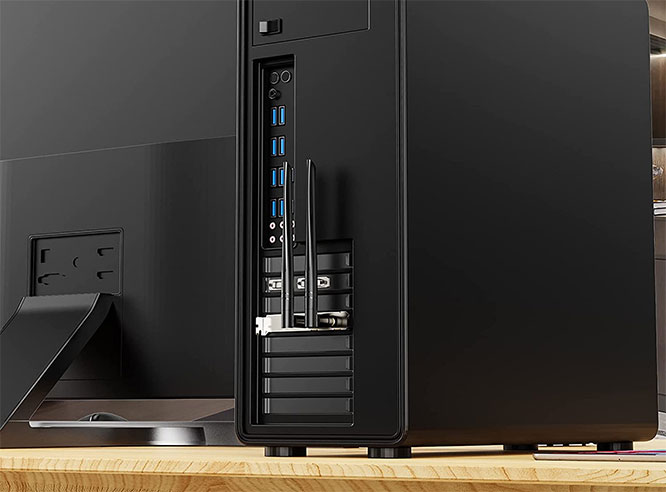
In fact, what card you choose can mean the difference between an enjoyable or a challenging user experience with your computer. There are an overwhelming number of options out there. We’ve leveraged our years of experience in the technology space to round up the top 5 WiFi adapter cards currently on the market.
You’ll notice that we are only including WiFi 6 network adapters on this list. WiFi 6 is the latest iteration that can deliver faster network speeds, simultaneously for a high number of smart devices throughout your home or office.
Many people invest large amounts of money into a WiFi 6 internet router but wonder why they don’t see a difference on their desktop computer. You need a WiFi 6-optimized network card in order for your computer to access the speed and features of this new technology. Lesser cards will serve as a bottleneck making your investment a waste.
For that reason, we are excluding WiFi network cards that use older technology in favor of cards that can future-proof you for at least the next few years.
Our Selection Process:
We’ve only included products in our roundup that we feel offer the best value and performance for our readers. Our team has used specific criteria to make our selections, which include:
- Quality Materials: It’s important that components are high quality and sourced from reputable sources. This plays a big role in aspects like overall performance and efficiency.
- Up-to-Date Technology: We only included network cards that operated on WiFi 6 connection technology. This ensures your computer is free of unnecessary bottlenecks or slow downs.
- Futureproof or Scalable: It’s important that your network card plays nice with other aspects of your wireless ecosystem. Even though wireless technology is moving at a fast pace, you want to do everything you can to make your investment stand the test of time for as long as possible.
- Brand Track Record: A quick online search will yield dozens of brands to choose from. We’ve done a thorough analysis into the manufactures of the cards in our roundup to make sure they have the reputation and track record of producing a high-quality, reliable product.
- Price/Value: You’re able to pick up a solid network card at nearly any price range. Going with the most expensive options doesn’t always mean it’s the best. We make sure the WiFi network cards on our list have enough value to justify the price that they charge.
Best Range: TP-Link Archer TX3000E PCIe WiFi Card
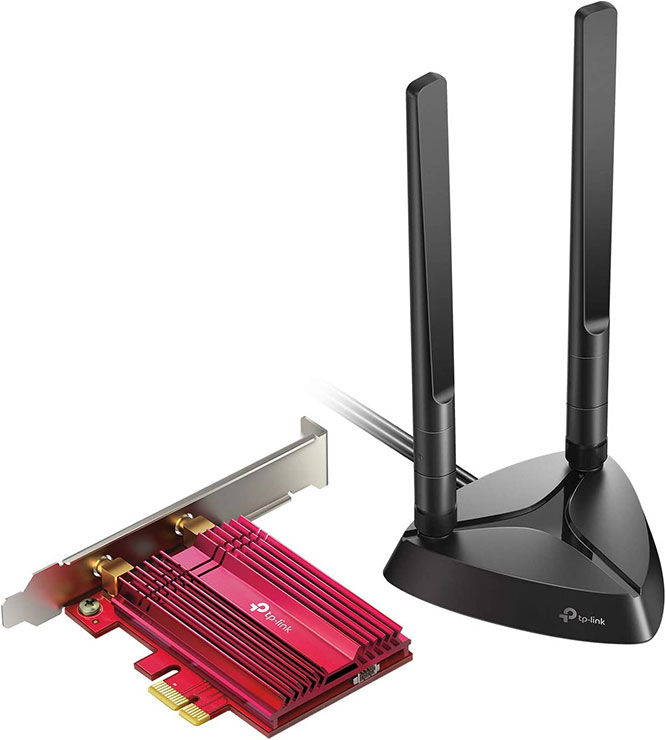
Key Features:
- Low latency.
- OFDMA & MU-MIMO technology for constant connectivity.
- Up to 2.4Gbps of speed.
- 2 Multi-directional antennas.
- Bluetooth 5.2.
The TP-Link Archer TX3000E tops our list as the best PCIe Wi-FI network card for range. Having a network card with a solid range means you don’t have to worry if your internet router is on the other side of the house. One thing to keep in mind is that things like clutter, furniture and interior walls can significantly reduce the range you have, regardless of what they advertise.
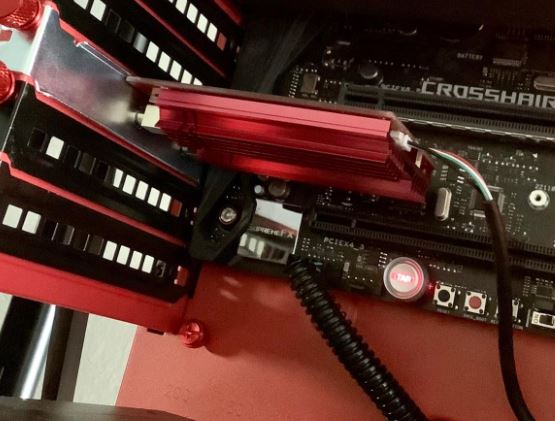
The TX3000E network card provides a rock-solid, uninterrupted connection using both OFDMA and MU-MIMO technology. Combined with WiFi 6, it’s an unbeatable combo at the moment.
An enormous challenge with long distances between your computer, and router is lag. The TP-Link manages this exceptionally well, providing some of the least amount of lag of any network card on the market. This is important for people that do things like live-streaming, Zoom or gaming.
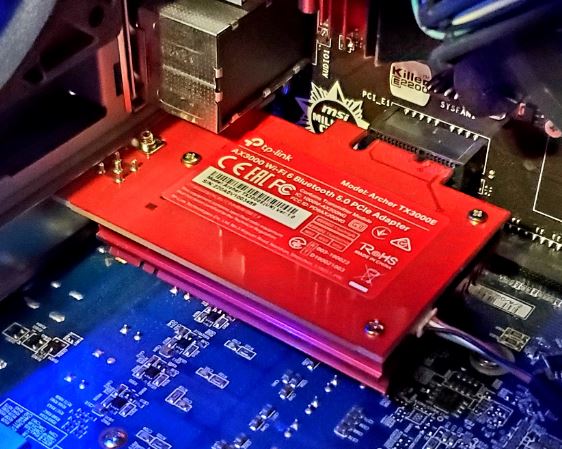
Our team liked the expanded coverage we could achieve from the two large multi-directional and high performance antennas. Overall, the TP-Link Archer TX3000E is a solid choice for anyone looking for powerful connection and fast speeds with incredible range.
What We Liked:
- Includes Bluetooth 5.2 for greater coverage and speeds.
- Two powerful antennas.
- Magnetic base on the external antenna.
- Range is as advertised even in spaces with several internal walls.
- Easy installation.
What We Didn’t Like:
- Installing drivers and initial setup can be challenging.
- Customer support can take some time to respond.
Best for Gaming: ASUS PCE-AC88 WiFi Card
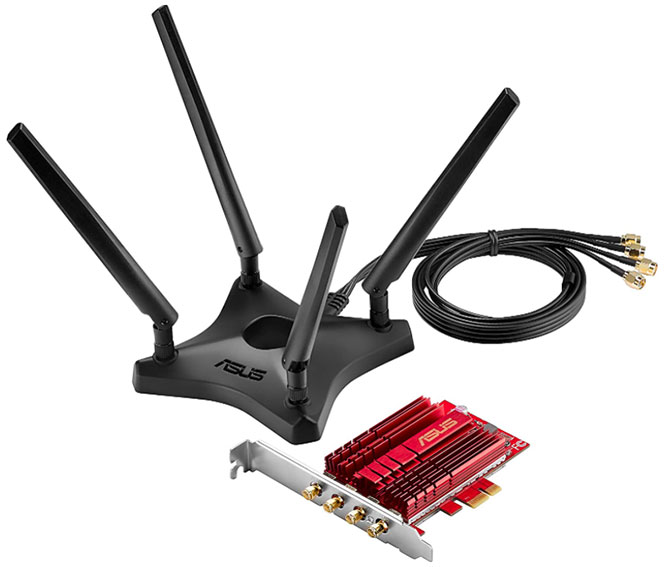
Key Features:
- Dual-band 4×4 AC3100 WiFi speeds.
- External magnetic antennas.
- Heatsink for better cooling.
- Low profile bracket.
The ASUS PCI-AC88 embodies everything we look for in the best WiFi card for gaming. Dual-band 4×4 AC3100 WiFi provides blistering speeds of up to 2100Mbps (5GHz band) and 1000Mbps (2.4GHz band).
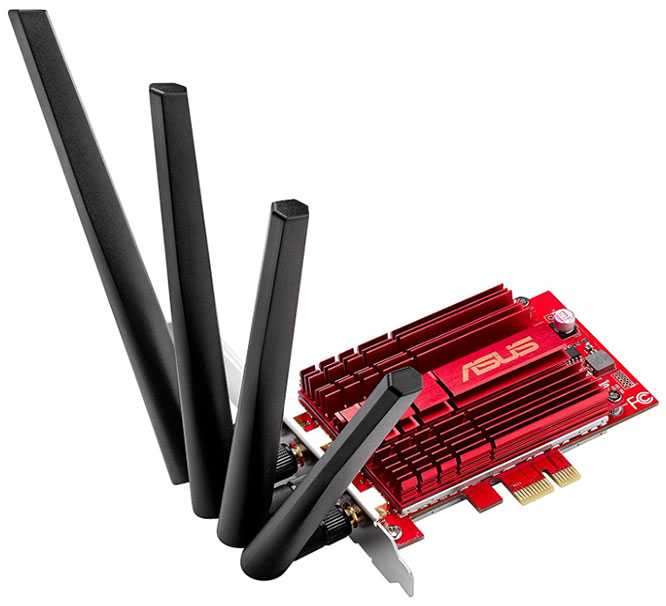
For added range, the ASUS PCI-AC88 provides two options to add antennas to the unit. Included in the box are four dipole antennas that can be attached using an external magnetic base and placed on your desk or on top of the desktop. If you’re looking for a less obtrusive option, there are R-sma antenna connectors that allow you to easily install aftermarket antennas directly onto the card.
Heat management and cooling is important for high performance environments such as gaming. Excessive heat can hamper performance and reduce the longevity of a computer’s components.
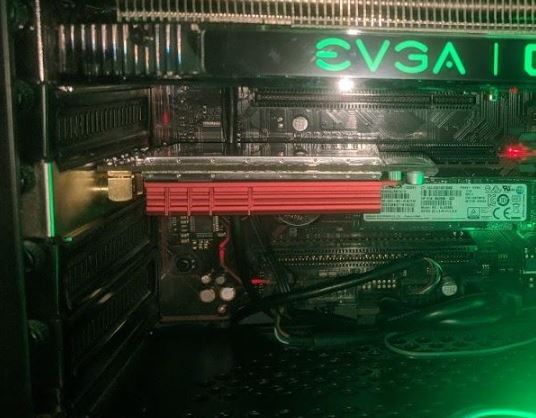
We really love the custom heatsink on the ASUS network card that works to dissipate heat produced by the device. This small but powerful feature allows your network card to deliver extremely fast speeds and performance without putting an additional burden on the onboard cooling system.
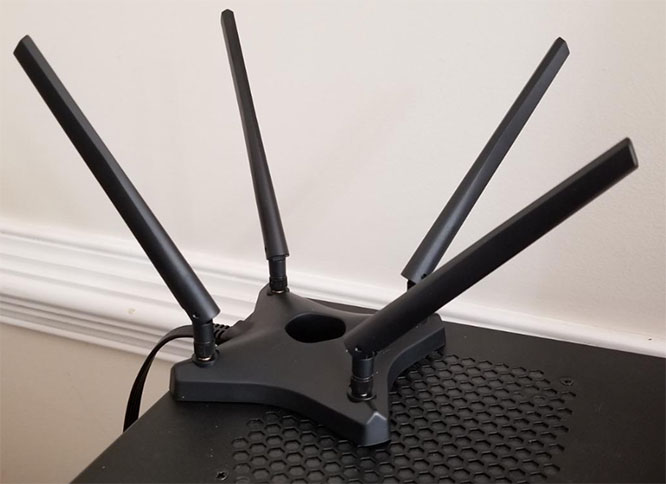
Many WiFi network cards lack the bandwidth to manage wireless online game play. Thanks to support for MU-MIMO technology, we found the ASUS PCI-AC88 to be ideal for limiting lag and providing a more responsive playing experience.
What We Liked:
- Supports MU-MIMO technology for less lag.
- Four antennas and a magnetic base for greater range.
- Custom heatsink.
- Fast speeds of up to 2100Mbps.
What We Didn’t Like:
- Typically more expensive than others.
- Antenna takes up a decent amount of space.
Best Alternative: ASUS PCE-AX58BT PCIe WiFii Card
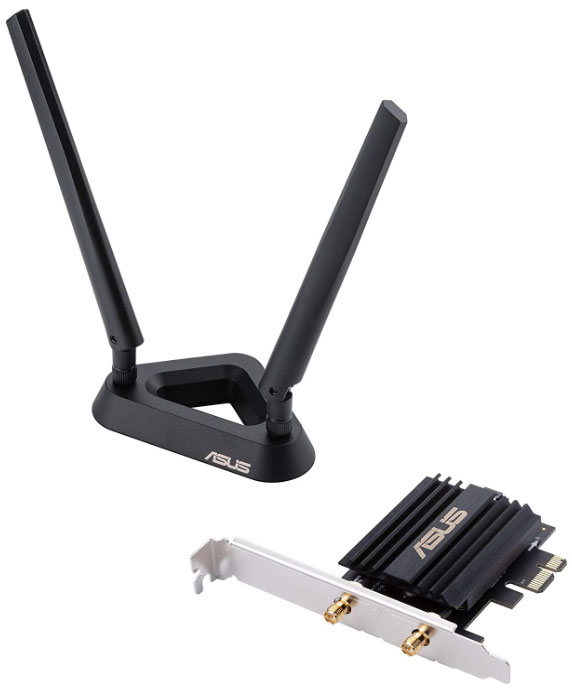
Key Features:
- Bluetooth 5.0.
- OFDMA & MU-MIMO technology.
- WPA3 security.
- External antenna base.
Our roundup would not be complete without including the ASUS PCI-AX58BT.
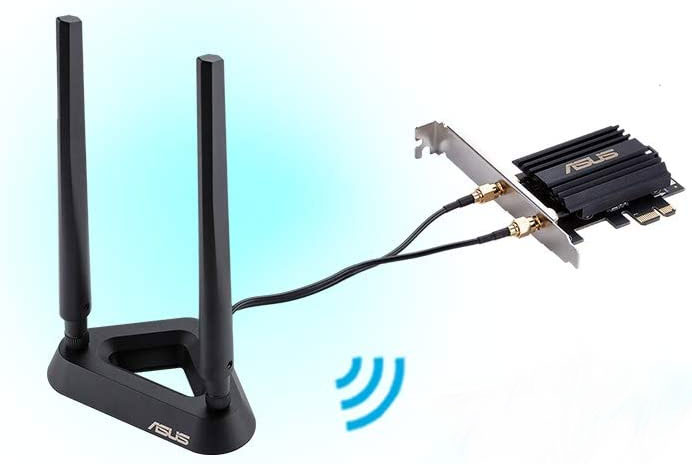
This network card leverages the power of WiFi 6 extremely well, providing a wireless experience that is incredibly fast and free of bottlenecks. According to a host of user reviews, this card can produce 2.7x faster speeds than previous generations of WiFi network cards.
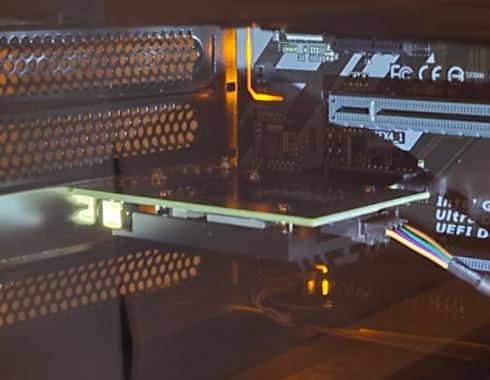
Its Bluetooth 5.0 makes it ideal for extremely fast transfer speeds and connectivity to multiple bluetooth devices such as keyboards, speakers and headsets. We appreciated the included antenna extension base which gives you placement flexibility to enhance coverage. It’s hard to beat a card with this feature set from an established brand.
What We Liked:
- Bluetooth 5.0
- 2.7x faster speed.
- OFDMA and MU-MIMO technology for less lag.
- External antenna base.
What We Didn’t Like:
- Installation with an included bracket can require extra tinkering to get right.
- Antenna performance is lacking.
Best 2nd Alternative: TP-Link Archer TX55E PCIe WiFi Card
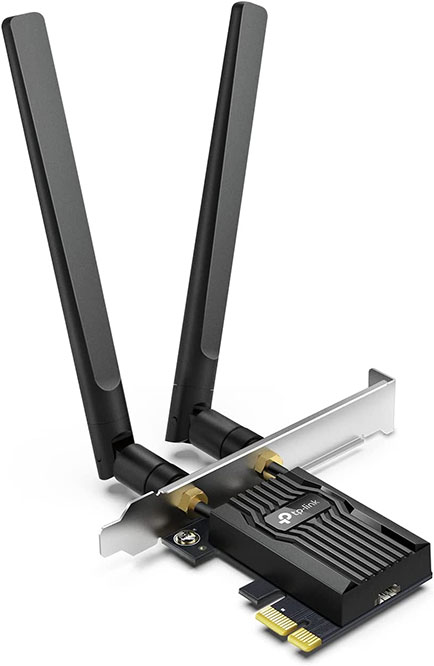
Key Features:
- 2402Mbps on 5GHz band.
- OFDMA & MU-MIMO technology.
- Double antennas.
- Bluetooth 5.2
The TP-Link Archer line of network cards are rock solid performers in the computer electronics space. When it comes to wireless network cards, the TX55E is a powerful performer. With speeds of up to 2402Mbps on the 5GHz band, it provides incredible speeds with uninterrupted connectivity.
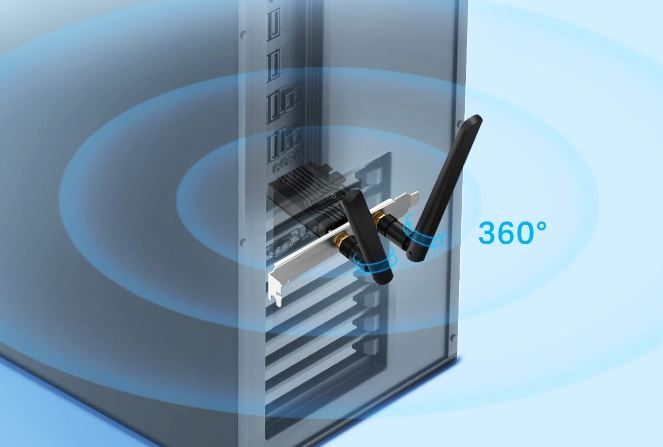
OFDMA and MU-MIMO technology minimize lag and improve responsiveness. This unit does not come with an antenna base extension but we found that the antennas that attach directly to the card do a great job of keeping the range high.
If you have a lot of Bluetooth devices to connect to your computer, the onboard Bluetooth 5.2 is capable of delivering 2x faster speeds and 4x more coverage. Overall, the TP-Link Archer TX55E is a solid choice at an incredible price.
What We Liked:
- Bluetooth 5.2 is extremely fast.
- High speeds at both 5GHz and 2.4GHz.
- Latest WPA3 security protocol.
- Comes with multiple brackets to match your tower’s needs.
What We Didn’t Like:
- Bluetooth function requires a USB cable to be connected to a F_USB connector.
- No antenna extension base.
Best Budget: Wavlink AX3000 PCIe WiFi Adapter
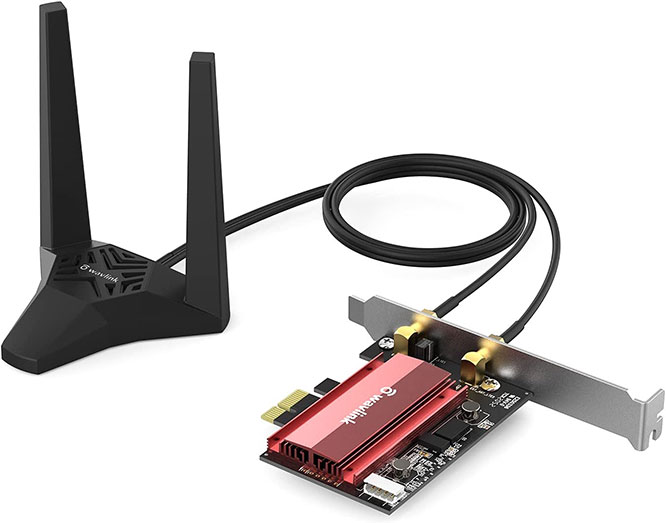
Key Features:
- Dual-band 4×4 WiFi.
- External magnetic antennas.
- Heatsink for better cooling.
The Wavlink AX3000 tops our list as the best budget WiFi adapter because it still leverages the latest wireless technology just in a more cost efficient package. While it lacks some bells and whistles of other options on this list, it still provides a solid, uninterrupted connection with only rare marginal lag.
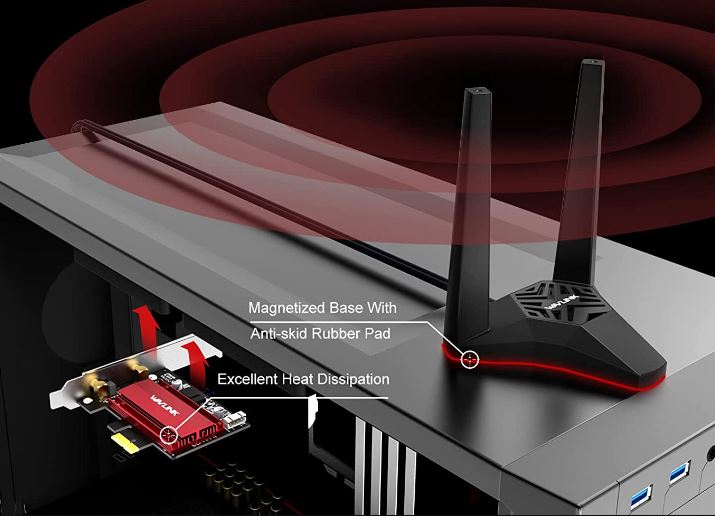
The installed MT7921K chipset extends WiFi speeds up to 3000Mbps which is solid even for network cards at even higher price points. These speeds are great for ultra-smooth gaming and VR experiences.
The magnetic antenna extension base helps to increase the range of your network card if your computer tower is on the floor. Users report this wireless card’s speed and connectivity are on par with the wired connections they had before. It’s an affordable way to rid your office space of additional wires.
What We Liked:
- Budget friendly.
- 6GHz band.
- Bluetooth 5.2
- Antenna extension base for greater range.
What We Didn’t Like:
- Driver installation sometimes requires a computer reboot before detecting device.
- MT7921K chip is not as stable as Intel.
- Bluetooth functionality requires additional hardware.
How to Choose the Best WiFi 6 PCIe Card
As you can see, there are plenty of options to match a wide range of needs. If you stil aren’t sure which network card is best for you, we’ve included some things to consider to help make your decision easier. Have a look.
Budget
There are great options regardless of your budget. However, you are going to have to make a list of priorities and be prepared to compromise on a few things as you go lower in price. Placing your router closer to your computer can help you save money by reducing the range you need.
Range & Coverage
Your card won’t do you any good if your range doesn’t reach the router. There’s a difference between marketed range and actual range. You’ll want to skim through user reviews to get a more accurate idea of just how much range you can get out of a specific network card. Also, the greater the range, the higher the price.
Bluetooth
Most of us have wireless keyboards and headsets. If you have over one or two Bluetooth devices, it’s important to make sure your WiFi 6 network card has the latest Bluetooth technology.
Speeds
If you intend to do data intensive activities like gaming or video conferencing, you will want to make sure your wireless card is up to the task. Try to make sure the data speed on your card is the same or higher than the capabilities of your router.
Meet Ry, “TechGuru,” a 36-year-old technology enthusiast with a deep passion for tech innovations. With extensive experience, he specializes in gaming hardware and software, and has expertise in gadgets, custom PCs, and audio.
Besides writing about tech and reviewing new products, he enjoys traveling, hiking, and photography. Committed to keeping up with the latest industry trends, he aims to guide readers in making informed tech decisions.

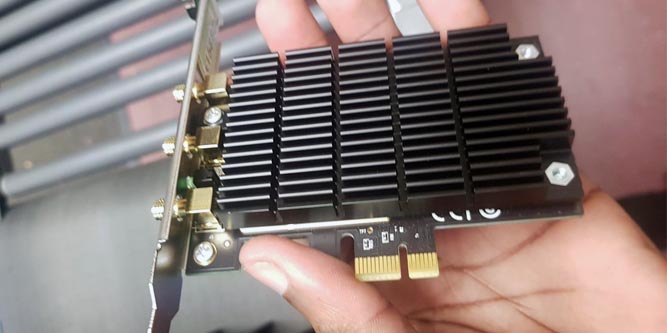
Sir,
My HP Laptop got problem to connect fiber net. it get connect cant brows and shows
DNS..error.
I check with repair shop he suggest to change the network adapter.
could pls adv me.
Thanks
A PCI wireless adapter won’t do you any good for a laptop. They’re made for desktop computers with an available PCI or PCIe slot on the motherboard. Sounds like you should contact HP directly.
desktop about 4 feet from router. cannot connect using on-board ethernet connection. which pci adapter card should i buy? ONLY USE COMPUTER FOR 78 year old mother AND INTERNET
Hello Vern! Sounds like you need something very basic. We’d recommend the Rosewill N300 WiFi Adapter as a cheap and decent option. If the computer is only used for basic web browsing, this should do just fine. Let us know if you have any other questions!
I have been using the TP-LINK Archer T9E for a few months now and haven’t had any issues with it. It was an easy upgrade and enables me to get a strong signal from upstairs in our 3,000 square foot home!
Yes, it’s quite nice. Thanks for letting us know!
Hi I’m planning to buy one of these need one under 100 dollars for online gaming and upstairs…do u recommend any good ones?
If you’re looking to keep the grand total under $100 go with the TP-LINK Archer T9E. Otherwise, priced a bit more, the ASUS AC1900 PCI-E Adapter is our favorite. Both are rated for the same bandwidth capabilities so either should work equally well for your specific situation.
Hi
thank you for your explanation .
I am planing to buy a wirless card for my pc , and I want one with huge range and powerfull connection but still not that expensive .
any suggestion ? please
I currently have a TP-LINK TL-WDN4800 PCI Wireless Adapter. And have had nothing but problems with it. For the longest time I had it and it would show three bars of my wifi, but say that it couldn’t connect to the Internet. While my laptop and iPad could do fine from the same area. Then a month ago the application in the cd it came with started to say that I didn’t have a wireless device, so I uninstalled it and tried to reinstall it, only for it to keep saying that it wasn’t finding the adapter. I don’t know if it’s just this model or what, but which adapter would serve me best for online gaming? Also I don’t know what model or make my modem is but could it also partial be a problem with that?
I should clarify that I could do things on the Internet from time to time with the wireless adapter, but it was so unreliable that gaming or watching video a majority of the time was impossible. Also I tried to use a wifi repeater to help get a better signal, but it doesn’t help.
Hello Church,
That’s really unfortunate that you’ve had problems with it. What Operating System are you using?
Could it be a faulty card? I would contact TP-Link and take advantage of their 2 year warranty and they should be able to replace it for you. Their phone number is +1 866 225 8139, or you can email them directly at support.usa@tp-link.com.
If you wanted to try another card that excels with gaming, I recommend the (PCE-AC68) from Asus. It’s the first option that we showcase in this post. It seems to be the best fit for most people, but it’s also a few extra dollars.
Also, I highly doubt that your modem has anything to do with it, but your router may be having compatibility issues with your wireless adapter. What’s the make/model of your router?
Hello. I’m buying a new computer and i’m going to build it myself, but i don’t have wired internet connection so i have to buy one of these cards, what card do you recommend? Also i’m going to play games with it (League of Legends, Counter Strike, H1Z1, etc.) so i need good ping.
Oh, and also I’m really on a budget so the cheapest possible would be nice
Hello Johny93, thanks for leaving a comment with your question! If budget isn’t an issue, we always reccomend the Asus PCE-AC68 (the first option above). However, if budget is a huge importance, go with the Archer T9E from TP-LINK (the second option above). They’re both capable of AC1900 speeds and should both suffice for the specific games you love to play. Please let us know if you have anymore questions.
Hey! I have the TP-LINK TL-WDN4800 PCI Wireless Adapter. When I first got the product, my internet was fast and fine, there was no problems, then just a few days ago, I started to get “lag spikes” while playing any games. Do you have any idea why this just popped out of no where, and what the problem could be?
Thanks!
That sounds a bit strange. How many devices and computers do you have on the network? How far are you away from your router? What kind (make/model) of router do you have? Honestly, it could be many different things – it might be hard to pinpoint exactly what’s causing it. Have you contacted TP-LINK? They offer good support for their products.
Thanks for your write-up. VERY helpful! Just picked up the new ASUS 4×4 AC3100 PCIe Adapter and I must say, it’s incredibly fast and there’s a HUGE improvement in my WiFi speeds. I’m using Windows 10 and it was a breeze to install. Just plugged it right in and I was good to go.
Awesome! Yeah the new Asus 4×4 AC3100 PCIe Adapter is downright phenomenal. A great buy and an easy upgrade for sure!
Purchased a TL-WN881ND 4 months ago and recently it started dropping internet connection despite the software saying that i have 60percent signal strength.. would like to know which fast, reliable card for under 50 bucks would you recommend.. must be reliable and be abkle to handle multiplayer gaming.. at the rate that this card is dropping internet connection it may stop working soon
Hey man!
I am stuck between the Asus AC-68 and the TP-Link Archer T9E. The T9E would fit perfectly for my build because its colour. The Asus would not fit very well, but I was just wondering. Is there a really big difference between them? I am planning to have my PC under the desk. My router is not far away just 8-9 meters I think and it does just face 1-2 walls.
Thanks! Awesome review!
Sounds like the T9E would do just fine for your scenario. Thanks for leaving a comment – no problem!
This is by far the best review I could find on PCIe wireless network cards–thank you!
My current setup is:
– Router: 802.11 a/b/g/n at a max speed of 300 Mbps
– Cable internet package only allows download speeds of “up to 30 Mbps” (I may someday upgrade to 150 Mbps)
– Current PCI network card (Belkin F5D7000) is slow at 54 Mbps
I mostly use my desktop PC for internet (including bitstreaming videos). The obvious bottleneck is my wireless network card and plan to upgrade (I have a free PCIe slot on my motherboard thankfully). I am strongly considering the Rosewill N600 because it’s cheap ($25 with shipping here in Canada) and (from what I can tell…would appreciate your confirmation) would remove the wireless network card as the bottleneck in my internet connection. But I am the type of person who likes to use my money towards something that will last so I’m considering the ASUS PCE-AC88 and PCE-AC68 too. My question is: In order to actually benefit from the ASUS PCE-AC88 or PCE-AC68 would I also have to buy a new router (will these even work with mine)? If so, which routers would you suggest (so I can see what the costs would be)? Or will my internet speed always be a bottleneck preventing me from benefiting with these more expensive network cards? Many thanks for your thoughts!
Which of the above work with Linux??
NOT the AC1900 (wasted money on that), and just about nothing from Rosewill. – sadly feels like 2001 again with lazy vendors cranking out incompatible junk in this space. Original author should have addressed this in article.
Thank you for sharing.
Very useful.
Faraz
I have been searching everywhere for a good card (at least 1300 mbps speed or more) that supports bluetooth. It seems, I can get a slower internt and bluetooth combo or just a fast wifi without bluetooth. Why is this? How can I get bluetooth on my new build without having to use a dongle? As a seperate option could I also just get a cheaper card but disable the wifi on it- then get a good TP-Link 1900 with it?
Exactly my dilemma right now. I was originally looking at the Gigabyte GC-WB867D-I since it just uses an internal USB header for the BT on the card and supports medium wifi speeds. But the reviews mentioned having a terrible time working the drivers for Win7, and that’s the platform I’m sticking with right now after ditching 10 when I had my laptop
What would you recommend for gaming online AND Livestreaming? My USB adapter at the moment isn’t cutting it. it used to be able to livestream to 1080p but then after a while, it keeps crashing. So, after reading a few reviews and such, I heard that the PCI adapters are better. So what would you recommend?
Gaming and live streaming are both high-demand activities. The more bandwidth, the better! Go with the Asus PCE-AC88.
Hi TechGuru, I’m not sure about all this wifi stuff myself. We have a Netgear wifi router that is hooked up to a Windows 10 laptop in the basement of our house. My desktop is a Dell Intel core 2 Duo Inspiron – 530 that came with windows Vista, but I had Windows 7 installed on it by a professional. All the programs I want to use for my art including my web pages is on my desktop that doesn’t have wifi. Also I can’t use my windows 10 laptop for my art because it won’t work with my digital Nikon transfer camera program. Windows 10 locks up all the time when I try to use it. I really want to be able to use my desktop since all my programs are already on it. Even though my desk top is in the room next to the router I have dead spots. I just bought a wifi adapter yesterday from Staples that plugs into the USB port on the front of my desk top. Needless to say it’s horrible. I installed my virus program yesterday which needed to update. I started the update at 3:00 pm and by 10:00 pm it was still updating. I ended up shutting of my desk top before it was completed. I’m positive it would still be updating now. Will the ASUS Dual-Band Wireless-AC1900 PCI-E Adapter (PCE-AC68) work with my desk top and how is it for handling heat? I know I’m going to need one that works well with dead spots because we have lots of them in our house. We ended up buying the Linskys Ac1750 Wifi range extender to use our laptops upstairs. We plugged the extender in the room that is right above the room where the router is because we couldn’t get it to work in other areas upstairs. We are now able to use our laptops upstairs most of the time. Any help would be very much appreciated!
The higher-end Asus units might be good, but the AC56 I’ve dealt with in the past is semi-garbage. No matter where you put the external antenna, a typical smartphone outperforms it. This is in a dorm room mostly, but performance was similarly inferior at home. I fought with it and managed to get maybe ~75% of the throughput of common Android and iOS devices in the same locations.
I always prefer Intel wifi adapters. Even on my AMD mITX boards, I’ve always gotten best results from using pretty much any Intel M.2 wifi/BT adapter, even with the same antennas! These days if a board comes with something cheaper, I’ll pop it out and slap in an Intel adapter. Speeds go up, and more importantly CONSISTENCY improved.
Also Intel’s drivers are better, at least for wireless. I had a friend with an entry level TP Link POS and the newest drivers are like two years old, and performance sucks regardless of whether you use their junk config software or let Windows manage it. Even an older cheap Intel M.2 wifi chip has fairly recent (and decent) drivers.
Would PCIE t9e would have difference over t6e besides its speed capacity?
I see that some of the cards you’ve listed are from 2015/16, such as the ASUS model. I know that Intel has released recently the AC 9260/9560, which claim to support 1.73Gbps. Supposedly, according to Intel’s website, https://ark.intel.com/products/99445/Intel-Wireless-AC-9260 the 9260 lists the System Interface Type as Wi-Fi(PCIe), BT(USB). This is going into a computer that doesn’t have the latest and greatest m.2 key E slot in it, so it has to be the PCIe for this system. As it was just released in Q4 2018, it appears to be the latest and greatest, but in all the pics I’ve seen, none of them show the adapter card, they all look like m.2 in the pics.
And of course, no one has any nearby, so I can verify it. The most amazing thing to me is that I found some available from resellers on Amazon (but none by Amazon themselves) priced around $25, but looking at that 3+ year old ASUS, (yes, it is 4×4, not 2×2 like the Intel, but the speeds are exceptional) priced at over $110, I’d have to say that is a hard sell for me. Can you get a hold of one of these new Intel pieces and add it to your review? Thanks!
Hi,
please suggest. I have my laptop on the first floor. Internet router is downstairs. its concrete floor. Right now i am getting anything between 2-9 MBPS using Virgin media 362MBPS broadband.
whats the best solution for me. i am ready to switch to Desktop. thanks
Question: Do these cards mentioned in your article also receive signals? The wi-fi receiver in my desktop is erratic. I have a router which services the whole house including streaming on our tv, just the desktop has dropping signal issues.